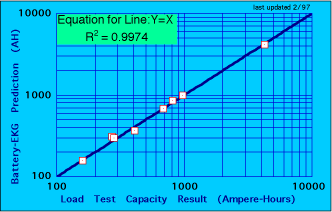

Accuracy and Measurement Principles of BATTERY-EKG
Our capacity predictions typically agree with load test results within 7 percent.
There is no upper or lower limit on the rated or actual capacity of the battery or cell that can be measured by our tests.
BATTERY - EKG uses a comprehensive, nonlinear, lead-acid cell equivalent circuit computational model for determining battery capacity. The model is based on well-established electrochemical principles, and is general to all types of lead-acid batteries, because the model determines the values of kinetic, physical chemical parameters related to energy storage processes. The instrument uses its measurements, in conjunction with the model, to provide actual cell capacities, in ampere-hours.
Consequently, "baseline," "trend," or battery manufacturer data, discharge curves, impedance, conductance, or resistance data are not needed by Battery-EKG for obtaining capacity.
Other on-line battery tests, in depending on baseline or trend information, implicitly suggest that the technical basis behind their measurements is not well understood.
A fundamental consideration for a battery test system's performance is its accuracy in predicting battery health. This is normally expressed through correlations between the unit's prediction, and the actual battery performance, as determined by a load test. A figure indicating the statistical significance of such correlations is the coefficient of determination, R^2, ("r-squared" value), with a value of 1.00 signifying a perfect agreement between prediction and load test.

Shown in the plot above is a comparison between overall battery capacity, as determined by our computational model, and independent load tests on valve-regulated and flooded batteries, with rated capacities from approximately 100 to 4000 ampere hours and actual capacities from approximately 30 to 100 percent. The coefficient of determination for BATTERY - EKG is over .997. The equation used for fitting the data is simply y=x, with no other parameters, and using the same computational model in all cases. To our knowledge, this represents the best statistical fit in the industry, by a significant margin.